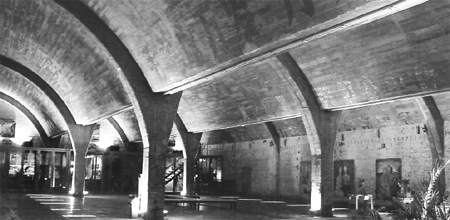Half a century ago it was a workshop churning out bullets and guns in the
Chinese capital city.
Now it has turned itself into an international community housing galleries,
salons, art shops and cafes and it is even called a Chinese type of New York's
SoHo.

Dashanzi's designers have turned
the district's Factory 798 into a web of cool post-industrial art spaces
while preserving traces of the past. [China
Daily] |
Known as "Factory 798," or more
commonly "798," the factory in the city's northeastern Dashanzi suburb of
Beijing, will be in a brighter spotlight by hosting the opening of the fourth
Beijing Dashanzi International Art Festival on April 29.
Artists from more than 40 countries and 150,000 visitors are expected to
gather for the spectacular with the theme "Beijing/Background," featuring
exhibitions including the visual arts, music, dance and drama.
"The festival will help open some artistic forms to the public and let the
whole society appreciate the experience," said Thomas J. Berghuis, an artist
from the Netherlands, who is here for the festival.
798 has attracted about 400 "permanent artist-residents," including 40 from
Germany, France, Great Britain, the United States, Italy, Belgium, Japan, and
other countries. In addition, about some 100 overseas Chinese artists have
returned to set up art shops here.
They can be seen in galleries, salons, studios, exhibition centers, design
companies, restaurants, cafes, and bars inside the former ordnance factory that
has been rented out, divided, and renovated into many sections, including "Now
Time," "798 Space" and "Ren Club."
The present Dashanzi Art District, which centers around 798, has become a new
rising art and culture community.
"The soul and charm of a city is determined by the city's atmosphere of human
culture. Therefore, 798 is a lot more than a landmark building to Beijing," said
Professor Yang Dongping, of the Beijing Institute of Technology, who specializes
in city culture studies.
798 is a large compound no different from any other Chinese factories,
surrounded by bustling streets, residential and commercial buildings. It is
architecturally simple and honest, emphasizing utility.
However, its former workshops' massive ducts and bright windows are unique in
the city's landscape. Its halls were built with aid from the former Soviet Union
in the 1950s, with the then East Germany providing architectural and industrial
design.